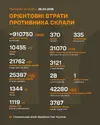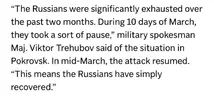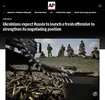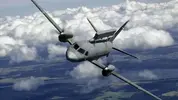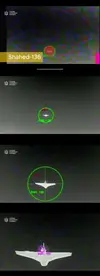Tanks, bases and factories of Muscovy as of early 2025
18 hours ago
Read 12 min
Reports of problems in the motorized component of Moscow's troops are being actively discussed online and in professional communities, as cases of the Moscow army using civilian cars for assault purposes, various kinds of homemade mobile vehicles, and in isolated cases using domestic animals for logistical support between positions have become more frequent.
To analyze trends in the armor potential of Moscow's occupation forces, the Resurgam think tank, together with
the Military Prophet OSINT community team, decided to update
last year's study of Moscow's reserves at storage bases, which was then conducted jointly with
Mortis Aeterna .
And let's start from the end. With some of the conclusions we came to during the research.
Conclusions reached during the implementation of the study.
1. We were forced to include units previously considered scrap metal in our calculations because new images from most storage sites showed activity in the "graveyard" area.
That is, in those areas of the bases where equipment was chaotically located, the restoration of which was practically equivalent to manufacturing a new unit from scratch, and sometimes even longer and more expensive, new images recorded activity for the first time in three years. Therefore, even empty "hulls" were calculated as a unit of equipment. Although, logically, it would seem, we should not have done this...
2. Counting tanks at storage bases based on images from February 2025 showed us that
since 2022, 2,069 tanks of various types have been removed from open-type (i.e., open-air) storage bases.
We also estimate that up to 2,000 tanks were kept in closed storage (i.e. in hangars), and, as the best units, the tanks from the hangars were removed first, which is confirmed by a number of images showing a long period of inactivity near the hangars.
In total, from 2022 to 2025, Muscovy decommissioned, according to our calculations, over 4,000 tanks of various types, which is 54%, or almost all tanks that were in good condition for restoration. As a result, it is important to note that
the rate of removal of tanks from storage bases has dropped significantly . While from 2022 to 2024 thousands of units were removed annually, from February 2024 to February 2025 the number of tanks removed from open storage was only 342 units.
At the same time, 3463 are at the main storage bases, which indicates the exhaustion of easily usable tanks for restoration, since armored tank factories need more and more time to restore a unit of equipment.
3. At that time, there were still 1,253 tanks on the sites of the armored factories themselves . It is worth noting that the number of tanks began to decrease for the first time from 1,500 in February 2024. This indicates a decrease in the rate of arrival of equipment from storage bases.
4. So, together, there are about 4,716 tanks at storage bases and armored repair plants. But it is extremely important to understand that most of them will not be restored or will be used as donors of spare parts for the restoration and maintenance of existing tanks.

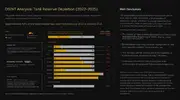
(tämän kuvan Google Lens käännös menee pieneksi tihruksi joten jätin alkuperäisen, suuremman kuvan tuohon yläpuolelle, koska siitä näkee tekstin ja numerot tarkemmin)
In general, our estimate is that about 1,200 tanks can still be restored from storage faster than they can be produced from scratch. The rest will take the same amount of time as producing one unit from scratch, which will have a catastrophic impact on replacing losses. We will discuss the arguments for this estimate and calculation later.
5. Counting ABMs. Since the images we received and acquired covered the main storage areas of armored combat vehicles — from BMP-1/2/3, BMD, MTLB, MTLB (u) to BTR-50/60/70, we decided to count them as well. The number of ABMs — from tracked to wheeled, stored at the main storage bases —
decreased by 43%, or by 3,252 out of 7,445 recorded at the bases studied as of 2021.
It is worth noting that as a starting point in 2021, we take data from researchers Jompi and Covert Cabal, who conducted a detailed study of these aspects.
Also, before considering each database, we think it is worth noting some interesting accompanying observations.
Interesting observations
- At Moscow storage bases, "equipment graveyards" have begun to be sorted out, in addition to equipment that was in storage. This is the first time during the observations and indicates a high level of depletion of available suitable stocks at storage bases to replenish losses.
- Winter images from various periods in 2024/25, tracks in the snow, and other observation tools allow us to record an almost complete absence of movement in the area of covered storage areas (i.e. near hangars). If at the beginning of 2024, certain movements of equipment from garages were recorded at individual bases, then as of December 2024/January 2025, there were no such movements. This gives us a certain opportunity to confirm that the equipment from garages, as the most suitable for restoration, has already been removed from storage and has either been sent to the front or to factories for restoration.
- To replenish the losses of the main armored infantry fighting vehicles (APCs), the decommissioning of the BTR-60/70 has begun. The transition from decommissioning of the BTR-1/2, MT-LB, MT-LBu to the less protected and wheeled BTR-60/70 indicates the depletion of the first of these vehicles suitable for rapid repair.
- Repair plants began to use equipment that was stored in their own settling tank areas . The equipment in these areas at the BTRZ was most often dismantled for export orders or modernizations and was stored without moving for more than 10-15 years. This indicates that the remains at the storage bases are of approximately the same quality as the equipment dismantled many years ago at the repair plant sites.
- The massively imported equipment from storage bases in 2022-2023 gradually began to decline in waiting areas, especially in the tank component. According to our estimates, from the second half of 2025, the restoration and modernization of T-80 tanks will be completed due to the fact that they are depleted at storage bases and waiting areas at armored repair plants.
- By the second half of 2025, tanks in “satisfactory condition” suitable for more or less rapid restoration will be exhausted. There will remain units that will require actual restoration from scratch, which means corresponding financial and time costs.
- From the second half of 2025, the main focus of restoration will shift to the T-62 and T-55 , which, although in poor condition, like the T-72 in storage, will be easier to restore when it comes to the need to restore virtually from scratch.
- According to our observations, the analysis of the movement of equipment from bases and BTRZ, as well as available data on the rate of recovery, allows us to build an approximate (I emphasize approximate) correlation of the rate of recovery/production of tanks: in 2022 - up to 120 units per month (or up to 1,500 per year). By the end of 2023, the rate had dropped to 90 units (or up to 1,100 units per year). But this rate of tank production (by production we mean recovery + production) approximately covered the current annual losses of the Moscow army.
At the end of 2024, the average production rate dropped to 50 tanks per month (up to 600 tanks per year), which is significantly lower than the rate of losses, given the need to replace 1,200-1,300 tanks per year.
The first observations for 2025 allow us to estimate a production rate of 30-35 units per month (or 360-400 tanks per year) with the potential for a sharp drop in the recovery rate at the end of the first half of 2025. The drop in the rate will be associated primarily with the exhaustion of T-80s suitable for recovery and modernization.
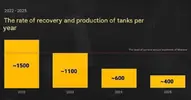 So what we see: from the second half of 2025, the current rate of replacement of tank losses of the Moscow army will hypothetically cover no more than 30% of the current losses at the front.
So what we see: from the second half of 2025, the current rate of replacement of tank losses of the Moscow army will hypothetically cover no more than 30% of the current losses at the front.
Therefore, the tank population will rapidly decline from 2025, which, in turn, will lead to a decrease in the involvement of equipment in assaults. And this, accordingly, will increase infantry losses during assaults, which will have corresponding consequences for the economy of the aggressor country.
Our conclusions are not a statement that Muscovy will be “without equipment”. Moscow is capable of producing and will be able to restore equipment from bases for some time. However, the intensity of the use of armored vehicles in assaults will continue to decrease due to the decline in the ability to replace losses. And this, in turn, will lead to a corresponding increase in infantry losses and an increase in the burden on the Muscovy budget for recruiting new soldiers and providing them.
In this case, the Moscow command will face a dilemma: either reduce the pace of the offensive to reduce the need for armored vehicles, or reduce the involvement of equipment in assaults and accept as a fact the increase in infantry losses with the corresponding military and economic consequences.
If the Moscow command attempts to maintain the current offensive pace by increasing the involvement of infantry, this will inevitably lead to a proportional increase in losses in the absence of a sufficient level of motorized support.
For example, by February 24, 2022, the Muscovite army had a staff number of about 3,200 tanks. From 2022 to 2024, Muscovite created an additional 11 divisions, which, according to calculations (approximately 187 to 210 tanks per division), should have brought the staff number of tanks to 5,000-5,100 units.
But according to OSINT data and comments from various intelligence agencies, including Ukrainian, there were about 2,200 tanks in Ukraine and near the borders at the beginning of 2024. Given the fact that at the end of the second half of 2024 the rate of losses exceeded the level of recovery, we can assume that as of 2025, the Moscow group has, according to our estimates, less than 2,000 tanks in Ukraine and near the borders. Or up to 40% of the required standard number.
In 2025, Moscow's industry will hypothetically produce, restore, or repair up to 400 units. That is, hypothetically, the group could have 2,400 tanks, but taking into account losses on the battlefield in 2025, if Moscow tries to maintain the pace of equipment deployment at the level of 2022/23/24, this will lead to the loss of 1,200 tanks in 2025, which will reduce the total number of tanks in combat units to 1,200 by the end of 2025 (i.e. 2,400, which could be, taking into account production, minus 1,200 tanks).
And this is only 23% of the required standard number of tanks. In the future, with each election cycle, the rate of tank production will decrease due to the poorer quality of the units that will be received for repair.
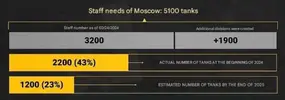
Since the so-called manufactured tanks in 80% of cases are tanks restored from storage bases, and only up to 20% are produced from scratch, this component will continue to be depleted. Of course, this will happen provided that the intensity and involvement of equipment are maintained.
The current production of tanks from scratch, according to the British International Institute for Strategic Studies, from May 17, 2022 to May 6, 2024, demonstrates that
Muscovy produced 164 T-90M tanks. Or approximately 80 tanks per year.
These are the only tanks that Muscovy can produce relatively from scratch. Although even these 80 units per year may include a certain amount of modernization from the T-90, of which there were over 100 at storage bases, to the T-90M version.
As a result, the reduction in mechanization will lead to increased losses and increase pressure on the Moscow budget: from payments for the dead and wounded, the maintenance of demobilized soldiers who have suffered injuries, to the need to increase spending on recruiting new soldiers and providing them.
Therefore, we emphasize that it is important to consider the decline in Moscow's ability to restore lost equipment not in the context of "When the tanks run out, the war will end." No. This is the wrong approach. There will always be a certain number of tanks and other armored vehicles (because they are being produced), but their insufficient production rates to replace losses trigger other processes — from economic to political and social.
Therefore, this information about storage facilities and recovery rates should be considered in conjunction with other factors, including: “What will this affect?” and what will be the consequences for the economy, and so on.
It is worth noting separately what recovery potential remains at the storage facilities.
The recovery potential remaining in storage facilities.
We have counted 3,463 tanks at storage bases. There are about 1,253 more tanks at waiting areas at armored tank factories. In total, there are 4,716. But it is worth understanding that not all of these tanks can and will be restored due to their technical condition.
For example, out of a total of 4,716 tanks, about 650 are T-64s, which cannot be restored due to the need for components manufactured in Ukraine. The only chance is smuggling, but how widespread it can be, given that a certain number of T-64s are already in service with the Moscow army and require maintenance, is a debatable issue.
So there are about 4000+ tanks left. Of these, about 2/3 are tanks in an extremely terrible technical condition and therefore require restoration from scratch. Therefore, most of them will rather be used as donors, and only a small part will go for restoration as a last resort.
Thus, only about 1,200 tanks can be restored somehow after a major overhaul. This will take more time and money, but will be slightly faster than producing from scratch.
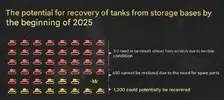
Ultimately, Moscow's defense industry still has to rebuild, but the question arises of the "pace of rebuilding," which is rapidly falling with the depletion of suitable equipment at storage bases.
We can already see in various manifestations that Moscow's troops are experiencing problems with mechanization. The available equipment still allows for mechanized assaults, but production is no longer able to compensate for current losses.
Next, we will consider interesting points about each of the bases separately and look at their local features.
ARTIKKELI JATKUU SEURAAVASSA VIESTISSÄ - OSA 2/3:
LINKKI
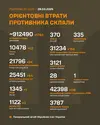

 ️VASTAUS AGRESSORIN TOIMIIN:
️VASTAUS AGRESSORIN TOIMIIN:
